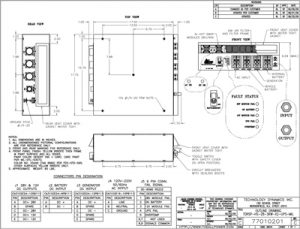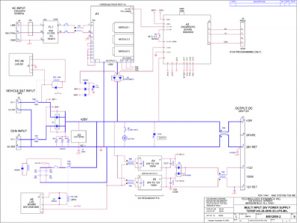DC 24V UPS FOR MILITARY VEHICLES
Most military vehicles with dedicated electronic system on board need a UPS to permit uninterrupted service. The UPS provides the backup time which permits to refuel a DC or AC generator which is the prime input source, or to shut down in an orderly way if a malfunction occurs on the input feed. This paper outlines the design options for such a DC UPS, and the issues discussed need to be considered while formulating the requirements for such UPS.
1. Option 1 through feed vehicle power to load
A simple DC UPS can be made for a military vehicle application by assuming that we can deliver the vehicle 24V to the output of the UPS, and when the vehicle battery falls to some low threshold, an internal backup battery within the UPS will continue to provide 24V to the load until such a battery is depleted. In this concept. The following should be considered.
(a) The output will be as good or bad as the vehicle battery and therefore not withstanding transients , it will vary between 28V down to 21V, as the vehicle battery with the engine off.
(b) if we allow the vehicle battery to fall to 21V, the occupants will not be able to start the engine since there will be weak cranking power. Therefore it is recommended to cut the load from the battery when it is down to 24V.
(c) The internal battery can operate subsequently until it reaches 21V but we are going on the assumption that the load can accept the full range of 30 ( battery float) down to 21V (d) While on vehicle battery the load does not see transients just steady state range.
(e) If the engine is running , the alternator produces 28V subject to steady state variations and transitory conditions listed in MIL-STD-1275 or the Def Stan 61-5 Part 6 which is more severe. The load will now have better regulated voltage close to 28V under normal conditions , but will not work under what is called emergency conditions when the voltage dips to 18V or engine cranking condition when the battery dips to 10V.
(f). the load probably will not survive the transients of the alternator caused by heavy load connecting and releasing elsewhere in the vehicle. Therefore even in this simple approach one has to filter the transients to the extent possible.
(g) The internal battery needs to be charged and we can use the vehicle alternator to charge it when the engine is running.
(h) In the USA the armed forces do not like to run the vehicle engine when not moving just to charge the vehicle battery and run the load of the DC UPS. This is not efficient and it makes the vehicle hot , thus detectable from above by infra red devices seeking hidden vehicles at night. US forces will in the non moving mode use a small generator ( 1-3KW) to supply well regulated voltage free from transients to run small loads like those of the DC UPS. In this case we will have 2 input sources of energy: The vehicle battery and alternator and an external DC 28V generator. In the case that an external generator ( may be located away from the vehicle or covered extensively for safety is used, the DC UPS is needed for 5-15 minutes to to continue running the load and allow the soldiers to refuel the generator when it runs out of gas. Usually 5 minutes is enough.
(i) The DC UPS can provide information via relay contact closure , or RS232 or SNMP to command and control that the load is running on vehicle battery or internal battery and what is the voltage of these sources at any time and it will warn about a pending shutdown when the input is too low. It can also inform C&C how much time is left on any source so they can plan accordingly
(j) When an external generator is used , it can also charge the internal backup battery
which will be connected to the load only if vehicle power and also possible external generator are off or below acceptable level. (K) US forces also require vehicle mounted UPSs to accept AC input power ( usually single phase) so that if an AC generator is used , the load can run on it instead of on the vehicle. Also, if the vehicle is near a an electrified facility, it can run on utility instead of vehicle or field generator. US forces use SAC generators extensively to run several systems or a whole shelter.
The attached drawings describe a top level DC and AC UPS unit which is now in design. It shows the schematic of such a unit and its outline drawing. This UPS is a Humvee mounted system and may be exposed to rain and desert dust. It is equipped with air filters and louvers. This UPS will accept AC from generator or utility in the USA or Europe ( 115 or 230V), DC generator 28V, and vehicle battery. It has a Cyclone type internal battery and thus can work over a wide range of temperature.
2. DC UPS with a regulated output
This may be the same as the above but now a DC DC converter is deployed to regulate the output from the summing point of all the possible sources to the load. It can also provide input to output isolation
This concept is more expensive and less reliable due to the use of the converter which working at high frequency . It generates more noise than the first concept
but it delivers a regulated output.
In the US, systems and loads intended for 24V input are required to work on battery range ( 21-30V) and therefore the first option above is viable although the voltage to the load is not regulated.


